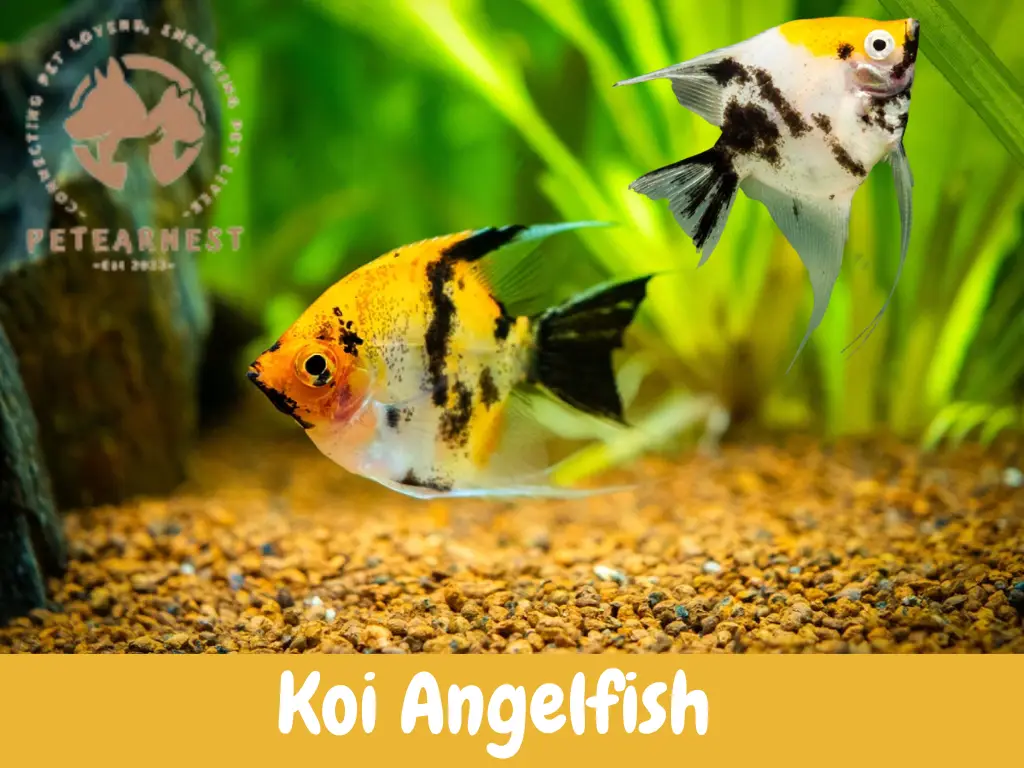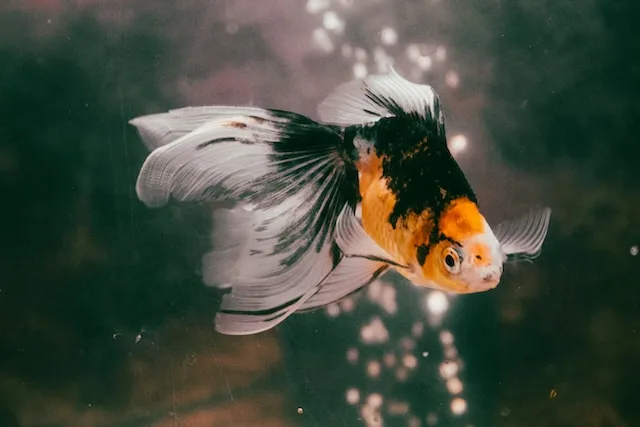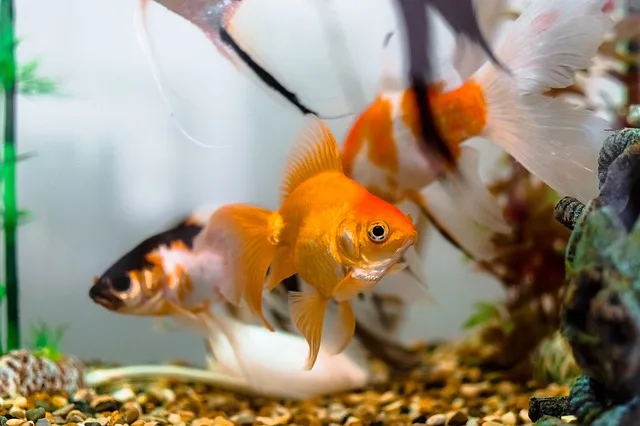Are you wondering whether Angelfish and Goldfish can coexist in the same tank? The truth may come as a shock, but the answer is no. While both fish species are popular among hobbyists for their beauty and ease of care, they come from different regions with distinct water requirements that make it difficult for them to live harmoniously together.
In this informative guide, we reveal the shocking truth about whether you can keep Angelfish and Goldfish in the same tank. Our experts explain the five key reasons why these fish should not be kept together, and provide advice on how to maintain a healthy aquarium for each species.
If you are considering keeping Angelfish or Goldfish, it is essential to understand their individual needs and how to care for them properly. Read on to learn more about these beautiful fish and how to ensure their well-being in your aquarium.
Angelfish and Goldfish
Goldfish and angelfish are two of the most popular fish species among fish keepers. While goldfish have been a favourite among kids for many years, angelfish have recently gained popularity due to their unique appearance and ease of care. However, despite their popularity, these fish have very different care requirements and come from different regions, making it challenging for them to coexist in the same tank.
Goldfish are known for their hardiness and adaptability to various water conditions, whereas angelfish require more specific water parameters to thrive. Additionally, goldfish are known to be messy eaters and produce more waste, while angelfish are sensitive to poor water quality. These differences in care requirements and behaviour make it difficult for goldfish and angelfish to make good tank mates.
In the following sections, we will dive deeper into the reasons why these fish should not be kept together, and provide tips on how to properly care for each species.
Angelfish

When discussing angelfish as potential tank mates for goldfish, it’s important to distinguish between the two species of angelfish. While marine or saltwater angelfish are not suitable for freshwater tanks and cannot coexist with goldfish, freshwater angelfish can be a potential option.
Freshwater angelfish, also known as Pterophyllum cichlids, are relatively peaceful and can be a good addition to many tropical community tanks. They come in various colors and patterns and are generally hardy and easy to care for. However, it’s important to note that while freshwater angelfish and goldfish may be able to live in the same tank, there are still potential challenges to consider.
For example, angelfish can grow quite large and may become aggressive towards smaller goldfish, especially if they feel their territory is being threatened. Additionally, angelfish have specific water parameter requirements, including warmer water temperatures, which may not be suitable for some types of goldfish. Therefore, careful consideration should be taken before deciding to house these two species together.
Goldfish

Goldfish are a popular species of freshwater fish that have been bred selectively for hundreds of years. They are believed to have originated from the Silver Prussian carp that were found in Central Asia’s colder waters. There are more than 125 varieties of goldfish, all belonging to the Cyprinidae family and the order Cypriniformes with the scientific name Carassius auratus. However, unlike other fish species that can be found in the wild, goldfish were artificially created through selective breeding.
Goldfish have been a popular choice for aquarium keepers because of their ease of care, hardiness, and vibrant colors. However, despite their popularity, it is important to consider their compatibility with other fish species, including angelfish. Due to their different care requirements, it is generally not recommended to keep goldfish and angelfish together in the same tank.
1. Behavior
When considering keeping fish together, it’s important to understand their behavior. Goldfish are peaceful and social creatures that need to live with other fish to thrive, ideally of similar varieties. On the other hand, adult angelfish are territorial and can be aggressive, especially when in spawning conditions.
While a group of juvenile angelfish can be kept together, they may need to be separated when they reach maturity to avoid territorial disputes. Additionally, only a few peaceful tropical species that can tolerate temperate water, such as White Cloud Mountain Minnows, Rosy barbs, Platies, Dojo loaches, and Corydoras catfish, can be kept with goldfish. It’s important to choose compatible fish species to ensure a harmonious environment and avoid stress or aggression among the fish.
2. Living Conditions
The reason why angelfish and goldfish cannot coexist is due to their different temperature requirements. Goldfish need a cooler temperature range, while angelfish require warmer waters.
If they are not kept in their preferred temperature range, both fish species will experience health issues and may even die. Therefore, it is not recommended to keep these fish species together in the same tank or pond.
i. Size Matters
The size difference between fancy goldfish and angelfish is significant. Fancy goldfish can grow up to 8 inches in length, while angelfish only reach around 3 inches in length and 6 inches in height. Slim-bodied goldfish, on the other hand, can reach up to 2 feet in length and need large aquariums or ponds to thrive.
For this reason, goldfish would require a much larger tank than angelfish. Additionally, angelfish are not well-suited for life in an outdoor pond setting. Therefore, it’s essential to consider the size and living conditions of both fish before attempting to keep them together in the same tank.
ii. Water Temperature
Goldfish and angelfish cannot coexist because they require different water temperatures. Goldfish are coldwater fish that prefer water temperatures between 62 and 72°F, while angelfish are tropical fish that need warm water temperatures between 75 and 86°F.
If the water temperature is too far from their preferred range, they can suffer from temperature shock, which can eventually lead to their death. Therefore, it is essential to keep goldfish and angelfish in separate tanks with water temperature conditions suitable for their respective species.
iii. Temperature Shock
Goldfish and angelfish require different water temperatures to survive. Goldfish are coldwater fish, and they need water temperatures between 62 and 72°F, while angelfish are tropical fish and require warm water temperatures of 75 to 86°F. If they are kept in water that is too far from their preferred temperature, they will suffer from temperature shock, which can ultimately lead to their death.
Fancy goldfish can tolerate slightly warmer water than their slim-bodied cousins, but they will still suffer from temperature shock if the water is too warm. Similarly, angelfish will suffer from temperature shock if the water is too cool for them. When fish suffer from temperature shock, they stop eating and become lethargic. Their circulation stops functioning correctly due to the lack of activity, leading to stress and compromising their immune system. This stress leaves the fish open to attack by parasites and bacterial diseases such as Ich and fin rot.
To avoid temperature shock, it is important to maintain the appropriate water temperature for each species of fish. If goldfish and angelfish are kept together in the same tank, one species will inevitably suffer, and their health will be compromised. Therefore, the main reason that goldfish and angelfish cannot live together is that they need completely different water temperatures to survive, and keeping them together could ultimately lead to their demise.
iv. Water Hardness
Water hardness is an important factor to consider when it comes to keeping fish. Goldfish and angelfish have different preferences when it comes to water hardness. While both species use minerals, they have different levels of tolerance. Angelfish prefer water that is soft and slightly acidic with a pH range between 6.0 to 7.5 and a water hardness of 5 to 13 dGH. On the other hand, goldfish prefer slightly harder water with a pH in the range of 7.2 to 7.6.
If the water hardness is not suitable for the specific species, it can lead to various problems, including poor growth and health issues. Water that is too soft for goldfish can cause osmoregulatory problems, while water that is too hard for angelfish can lead to problems with their gills and kidneys. Therefore, it is crucial to ensure that the water hardness is within the preferred range of the species you are keeping to ensure their optimal health and well-being.
3. Tank Maintenance

Maintaining a clean tank is essential for the health of both goldfish and angelfish, but goldfish are particularly notorious for generating large amounts of waste due to their eating habits. Without a proper filtration system, the water in a goldfish tank can quickly become polluted, leading to high levels of ammonia and nitrate. This can be harmful not only to the fish but also to the overall aquatic environment. Partial water changes are necessary to keep the nitrate levels under control, and the filter needs to be cleaned regularly to prevent blockages.
Angelfish are less messy than goldfish, but they still require clean water conditions to thrive. Regular water changes and proper filtration are also important for their well-being. Additionally, angelfish are more sensitive to changes in water chemistry, so it’s essential to maintain consistent water conditions to avoid stress and disease.
In summary, keeping a clean tank and ensuring proper filtration is vital for both goldfish and angelfish, but goldfish require more frequent maintenance due to their higher waste production.
4. Water Movement
Both angelfish and fancy goldfish have different swimming styles, and they both prefer still water rather than a strong flow or excessive water movement. Fancy goldfish are not strong swimmers and can get easily stressed in turbulent water, while angelfish prefer to glide through calm water without much effort.
Therefore, it is essential to use decorations or plants to buffer any strong currents from the filter, ensuring that the water movement is minimal for both species. If the water movement is too strong, it can lead to health problems, including stress and poor oxygenation, which can ultimately lead to the death of the fish.
So, it is crucial to maintain a suitable environment for both species, and one of the best ways to do so is to ensure that the water flow is gentle and peaceful.
5. Tank Decoration
When it comes to tank decoration, it’s important to keep in mind that both goldfish and angelfish need enough space to swim. Decorations like roots, stones, and driftwood can be used, but they should not block the swimming space.
While aquatic plants can add aesthetic value to the tank, goldfish may uproot and nibble on them, causing damage. Therefore, using plants in a tank with goldfish is not recommended.
On the other hand, angelfish can coexist with plants and they can be used to create a more visually appealing environment for them.
Goldfish With Angelfish – A Temporary Arrangement?
In a dire emergency where your angelfish tank heater fails, it is theoretically possible to keep angelfish with goldfish for a day. This is only applicable if the room where your goldfish tank is kept is warm enough to keep the tank water temperature at the minimum required by the angelfish. This could work until you replace your heater. However, a separate hospital tank is recommended as a temporary place for your angelfish to live.
Goldfish are hardy fish that can live happily in cold water and don’t need any form of heating in their tank, even in a cool climate. They would find it far too warm for comfort in a tropical tank where angelfish reside. The difference in water temperature could cause stress for the goldfish and affect their health.
Having a separate hospital tank is crucial as it will enable you to monitor and treat your angelfish for any illness without risking the health of your goldfish. Keeping them together could result in the spread of diseases, as well as an increased risk of aggression and predation. Therefore, it is best to keep them in separate tanks with appropriate conditions for each species.
In conclusion, while it is possible to keep angelfish with goldfish temporarily in a dire emergency, it is highly recommended to have a separate hospital tank for your angelfish. This will ensure the health and wellbeing of both species and prevent any negative consequences of keeping them together in the same tank.
https://youtu.be/JV6Oy9cI6xc
What Kind of Fish Can Live With Goldfish?
When it comes to choosing tankmates for goldfish, it’s important to keep in mind that goldfish are coldwater fish and need compatible tankmates. Some carnivorous fish should not be kept with goldfish, as they may turn the goldfish into a snack. Here are some examples of fish that should not be kept with goldfish:
-
Pufferfish: Pufferfish are known to nip at the fins of their tankmates and should be kept in a species-only tank.
-
Piranhas: Piranhas are aggressive and ferocious schooling fish that prey on other fish. They should not be kept with goldfish, as they may eat them.
-
Oscar: While Oscars and goldfish may grow to a similar size, Oscars have a diet that includes small goldfish, and they may eat their tankmates.
-
Arowanas: Arowana keepers often feed their fish with goldfish, so they should not be kept together.
-
Larger carnivores: Carnivorous fish may make a snack out of smaller goldfish, so it’s important to keep them separate.
It’s best to keep goldfish with herbivorous or omnivorous fish, such as plecos, neon tetras, corydoras, and other goldfish. When selecting tankmates, consider their temperament, diet, and size. Aggressive fish, carnivorous fish that prey on other fish, and fish that are much larger than goldfish should not be kept together. The difference in size could cause stress for the goldfish.
In conclusion, it’s important to carefully consider tankmates for goldfish, as they have specific requirements for water temperature and compatible tankmates. Choosing appropriate tankmates will create a peaceful and harmonious environment for all the fish in the tank.
https://youtu.be/ldbE9N7RUTQ
What Kind of Fish Can Live With Angelfish?
Angelfish are warm-water fish that originate from the amazon, and while they can be kept with other fish, it is important to ensure that there is enough space in the tank to prevent aggression. It is also important to consider the size of tank mates as angelfish have been known to eat smaller schooling fish such as neon tetras.
Suitable Tank Mates for Angelfish:
When selecting tank mates for angelfish, it is best to choose non-aggressive fish that are larger in size and cannot fit into the mouth of the angelfish. Some suitable options include:
- Adult platies
- Plecos
- Dwarf gouramis
- Swordtails
- Ram Cichlids
- Mollies
- Bettas
Fish to Avoid:
It is important to avoid smaller fish such as neon tetras and guppies as they may be eaten by the larger angelfish. Additionally, it is best to avoid aggressive fish as they may cause stress and harm to the angelfish.
Conclusion:
While this list is not exhaustive, it is important to consider the size and temperament of potential tank mates when selecting fish to live with angelfish. Non-aggressive fish that are larger in size and cannot fit into the mouth of the angelfish are generally safe options to consider.
https://youtu.be/mERUBqnxCKg
Final Thoughts
“It is not advisable to keep angelfish and goldfish together in the same tank due to differences in water temperature, diet, and behavior. Angelfish require warm water and a high-protein diet, while goldfish prefer cooler water and a plant-based diet. Additionally, angelfish can be aggressive and territorial, while goldfish are peaceful and social creatures. Separate tanks are recommended to ensure the well-being and happiness of both species.”
Dr. Chandrika
Tweet
In conclusion, it is not advisable to keep angelfish and goldfish together in the same tank. There are many reasons why they cannot coexist, such as differences in water temperature, diet, and behavior. Angelfish are tropical fish that require a warm water temperature of around 78-82°F, while goldfish are coldwater fish that prefer a temperature between 65-72°F. Furthermore, angelfish are carnivores and need a high-protein diet, while goldfish are herbivores that feed on plants and algae.
Additionally, angelfish are known to be aggressive and territorial, while goldfish are peaceful and social creatures. Angelfish may attack and eat smaller fish, including goldfish, and they may also bully them. Therefore, it is best to keep these fish species in separate tanks to ensure their well-being and happiness. In case of emergencies, a temporary arrangement could be made, such as placing the angelfish in a hospital tank or in a tank with larger, non-aggressive fish that can tolerate warmer water temperatures.
Attention all #aquarium enthusiasts! Keep your #angelfish and #goldfish happy and healthy by not keeping them together. Learn why in our latest article and keep your fish thriving. #fishkeeping #aquaticpets #petcare #aquariumtips #fishtanks pic.twitter.com/7dCW4uP0e9
— PetEarnest (@Pet_Earnest) April 30, 2023


